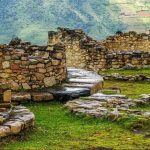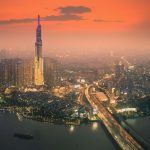A look at why the city is a must-see on itineraries to Vietnam
Mitchell McClung
Formerly known as Saigon, Ho Chi Minh City was often referred to as the “Pearl of the Far East” – recognized as one of the most dynamic and economic centres of the region. In 1976, the city was renamed to Ho Chi Minh City in honour of president Ho Chi Minh. Today, the city stands as Vietnam’s economic hub and a major travel gateway, serving as a convergence point for diverse cultures and cuisines.
The streets of Ho Chi Minh city are teeming with people and a cacophony of cars, buses and the motorcycle, a ubiquitous fixture of Ho Chi Minh City. The motorcycle is arguably the best and cheapest way to travel around the city, and ambitious tourists can experience the thrill of riding as a passenger on one of the thousands of motorcycle taxis, known as Xe Om. For travellers, hopping on a motorbike taxi isn’t just a way to get around; it’s a thrilling way to feel the heartbeat of the city, guided effortlessly through ride-hailing apps that make every ride an adventure.
Architecturally, visitors will see that this city has roots reflected in its rich history combined with robust development reflecting the strength of the up-and-coming Vietnamese economy and the growth into industrialization. French colonial architecture remains part of the city’s legacy, with highlights including the People’s Committee of Ho Chi Minh City, the Notre Dame Cathedral, the Central Post Office and the Saigon Opera House. The French presence in the country lasted until 1954 and this remains part of the city’s mosaic today. In direct contrast to the colonial French architecture are the looming modern skyscrapers of Sai Gon Ward (formerly District 1). Soaring majestically at 81 stories, Landmark 81 was built to reflect Ho Chi Minh City’s prosperity and modernity, inspired by the country’s traditional bundle of bamboo. In addition to breathtaking views of the city, visitors can enjoy a shopping mall, restaurants and a hotel.
For a more traditional local shopping experience, Bến Thành Market is the most iconic place to shop and eat. There are 1500 booths featuring 6000 small businesses selling everything from textiles (Vietnam is one of the largest producers of textiles in the world) to art and ceramics to fresh food, fruit and vegetables. The night market focuses more on food stalls and visitors can enjoy some of world-famous street food dishes at very affordable prices. Travellers can sit down with locals at a street stall and enjoy notable dishes such as Pho, a flavourful large soup of noodles and optional types of meat like beef, beef balls, chicken, seafood etc, or a Banh Mi, a delicious sandwich that combines a French style baguette with Vietnamese flavours and flair. Visitors can also enjoy Vietnamese flavours in dishes that are not always available on the menus at home, such as Bo La Lot (Minced meat wrapped in Betel leaves) or Banh Xeo, which are crispy and savoury pancakes filled with beef, pork or shrimp.
The Chinese Quarter, Cho Lon, switches gears and offers a large wholesale market, narrow lanes with Chinese food stalls and restaurants, plus engaging cultural sites such as the Thien Hau and Ong Bon Pagodas. The Ong Bon Pagoda is a beautiful homage to traditional Chinese culture in Vietnam and represents the multi-ethnic diversity of Ho Chi Minh City. In addition to the Vietnamese, Chinese and French legacies, there are also Khmer and Cham communities, all contributing to a rich cultural mosaic.
Ho Chi Minh City offers a rich museum scene that captures its history, culture, and creativity. Visitors can explore the War Remnants Museum, History Museum, and Fine Arts Museum to better understand the city’s past and artistic spirit. Unique spaces like the Ao Dai Museum also celebrate Vietnam’s timeless traditions, making every visit both educational and inspiring.
The Cu Chi Tunnels offer a fascinating journey into Vietnam’s wartime history and the resilience of its people. Stretching over 200 kilometers, this underground network once served as a vital base during the war. Recognized as one of the Top 7 most adventurous destinations in Southeast Asia and among the Top 12 most captivating underground wonders in the world, the tunnels promise an unforgettable experience for every visitor.
Ho Chi Minh City offers travellers a fantastic introduction to Vietnamese history, culture, food and its modern ambitions. It provides an excellent starting point for visitors wishing to go further into Vietnam and enjoy their extensive suite of engaging destinations, or as a stand-alone experience where travellers can immerse themselves in the rich tapestry of the city’s interesting sites and attractions.

















